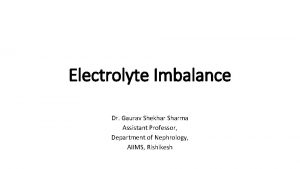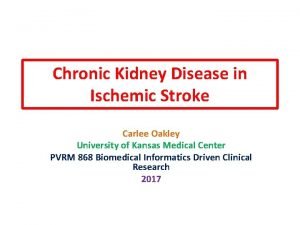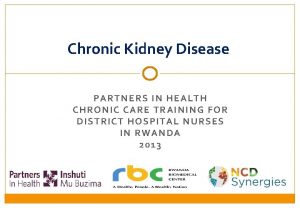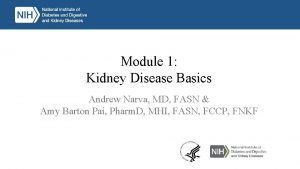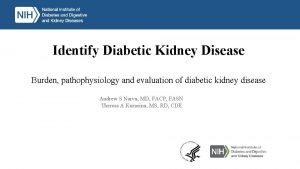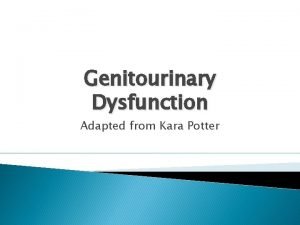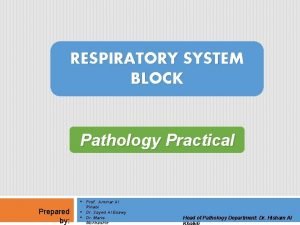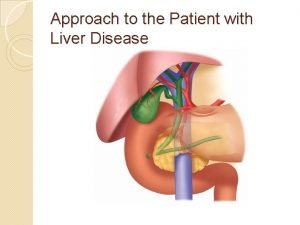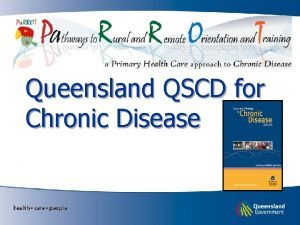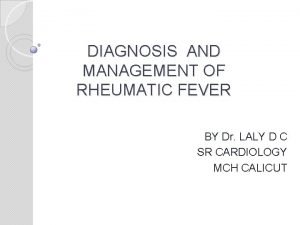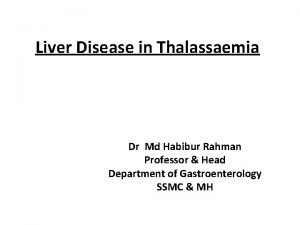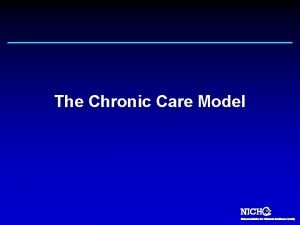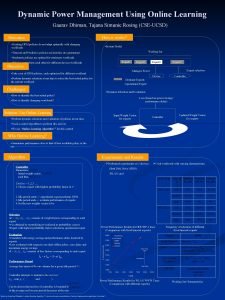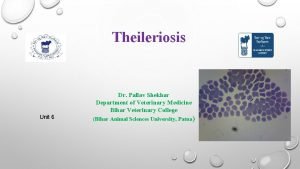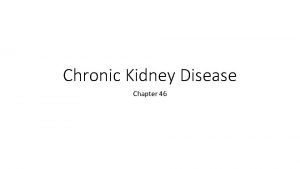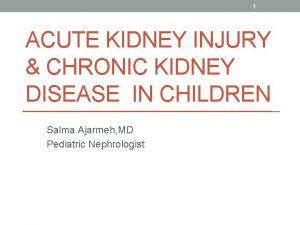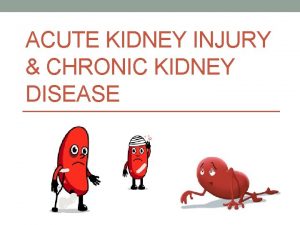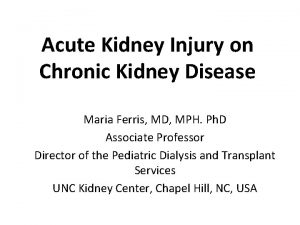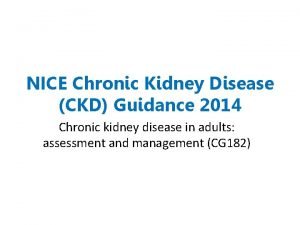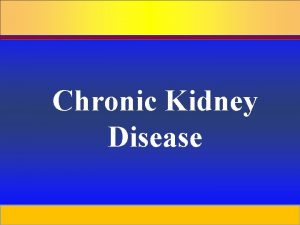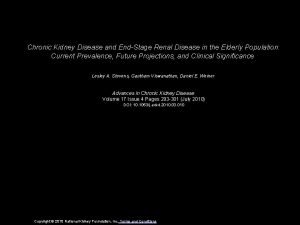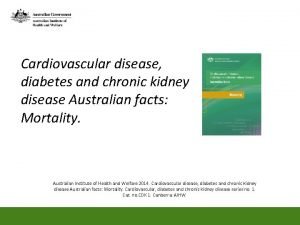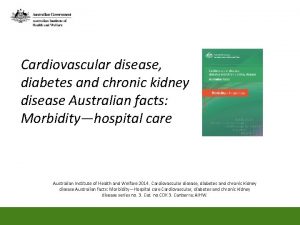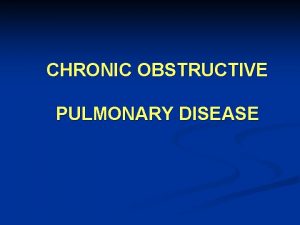CHRONIC KIDNEY DISEASE Dr Gaurav Shekhar Sharma Assistant




































- Slides: 36

CHRONIC KIDNEY DISEASE Dr. Gaurav Shekhar Sharma Assistant Professor, Department of Nephrology AIIMS, Rishikesh


Staging • Chronic kidney disease (CKD) encompasses a spectrum of different pathophysiologic processes associated with abnormal kidney function and a progressive decline in glomerular filtration rate (GFR), present for >3 months.

• PATHOPHYSIOLOGY OF CHRONIC KIDNEY DISEASE – • initiating mechanisms specific to the underlying etiology • a set of progressive mechanisms, involving hyperfiltration and hypertrophy of the remaining viable nephrons, that are a common consequence following long-term reduction of renal mass, irrespective of underlying etiology • Eventually, these short-term adaptations of hypertrophy and hyperfiltration become maladaptive leading to sclerosis and dropout of the remaining nephrons

RISK FACTORS • • • small for gestation birth weight childhood obesity hypertension diabetes mellitus autoimmune disease advanced age African ancestry a family history of kidney disease a previous episode of acute kidney injury presence of proteinuria abnormal urinary sediment structural abnormalities of the urinary tract.

• The normal annual mean decline in GFR with age from the peak GFR (~120 m. L/min per 1. 73 m 2) attained during the third decade of life is ~1 m. L/min per year per 1. 73 m 2, reaching a mean value of 70 m. L/min per 1. 73 m 2 at age 70.

Etiology of CKD • • • Diabetes Hypertension Glomerulonephritis Hereditary cystic and congenital renal disease Interstitial nephirits and pyelonephritis

Evaluation • estimation of GFR – only when creatinine levels are steady • Measurement of albuminuria – • 24 -h urine collection • protein-to-creatinine ratio in a spot first-morning urine sample

Clinical features • Stages 1 and 2 CKD - asymptomatic • stages 3 and 4 - clinical and laboratory complications of CKD • most evident complications include • anemia and associated easy fatigability; • decreased appetite; • abnormalities in calcium, phosphorus, and mineral-regulating hormones, such as 1, 25(OH)2 D 3 (calcitriol), parathyroid hormone (PTH), and fibroblast growth factor 23 (FGF-23); • and abnormalities in sodium, potassium, water, and acid-base homeostasis.

Clinical manifestations Uremia • Syndrome that incorporates all signs and symptoms seen in various systems throughout the body

Uremic symptoms

Urinary system • Polyuria • Results from inability of kidneys to concentrate urine • Occurs most often at night • Specific gravity fixed around 1. 010 • Oliguria • Occurs as CKD worsens

Metabolic disturbance • Waste product accumulation • As GFR ↓, BUN ↑ and serum creatinine levels ↑ • BUN ↑ • Not only by kidney failure but by protein intake, fever, corticosteroids, and catabolism • N/V, lethargy, fatigue, impaired thought processes, and headaches occur

Electrolyte/acid–base imbalances • Sodium • May be normal or low • Because of impaired excretion, sodium is retained � • Water is retained • Edema • Hypertension • CHF • Potassium • Hyperkalemia • Most serious electrolyte disorder in kidney disease • Fatal dysrhythmias

• Calcium and phosphate alterations • Magnesium alteration • Metabolic acidosis • Results from -Inability of kidneys to excrete acid load (primary ammonia)

Hematologic system • Anemia • Due to ↓ production of erythropoietin • From ↓ of functioning renal tubular cells • Bleeding tendencies • Defect in platelet function • Infection • Changes in leukocyte function • Altered immune response and function • Diminished inflammatory response

• Anemia treatment • Erythropoietin • Administered IV or subcutaneously • Increased hemoglobin and hematocrit in 2 to 3 weeks • Side effect: Hypertension • Iron supplements • If plasma ferritin <100 ng/ml • Side effect: Gastric irritation, constipation • May make stool dark in color • Folic acid supplements • Needed for RBC formation • Removed by dialysis • Avoid blood transfusions

Cardiovascular system • • • Hypertension Heart failure Left ventricular hypertrophy Peripheral edema Dysrhythmias Uremic pericarditis

Respiratory system • • Kussmaul respiration Dyspnea Pulmonary edema Uremic pleuritis Pleural effusion Predisposition to respiratory infections Depressed cough reflex “Uremic lung”

Gastrointestinal system • • • Mucosal ulcerations Stomatitis Uremic fetor (urinous odor of the breath) GI bleeding Anorexia N/V

Neurologic system • Expected as renal failure progresses • Attributed to • • Increased nitrogenous waste products Electrolyte imbalances Metabolic acidosis Demyelination of nerve fibers Altered mental ability Seizures and Coma Dialysis encephalopathy Peripheral neuropathy

Restless leg syndrome • Muscle twitching • Irritability • Decreased ability to concentrate Reproductive system • Infertility • Experienced by both sexes • Decreased libido • Low sperm counts • Sexual dysfunction

Musculoskeletal system • Renal osteodystrophy • Syndrome of skeletal changes • Result of alterations in calcium and phosphate metabolism • Weaken bones, increase fracture risk • Two types associated with ESRD: • Osteomalacia • Osteitis fibrosa


• Phosphate intake restricted to <1000 mg/day • Phosphate binders • Calcium carbonate • Bind phosphate in bowel and excreted • Sevelamer hydrochloride • Should be administered with each meal • Side effect: Constipation • Supplementing vitamin D • Calcitriol l) • Serum phosphate level must be lowered before administering calcium or vitamin D

• Controlling secondary hyperparathyroidism • Calcimimetic agents • ↑ Sensitivity of calcium receptors in parathyroid glands • Subtotal parathyroidectomy

Integumentary system • Most noticeable change • Yellow-gray discoloration of the skin • Due to absorption/retention of urinary pigments • • Pruritus Uremic frost Dry, pale skin Dry, brittle hair Thin nails Petechiae Ecchymoses

Nutritional therapy • Protein restriction • 0. 6 to 0. 8 g/kg body weight/day • Water restriction • Intake depends on daily urine output • Sodium restriction • Diets vary from 2 to 4 g depending on degree of edema and hypertension • Potassium restriction up to 2 to 4 g • Phosphate restriction up to 1000 mg/day

Hemodialysis • Artificial replacement in case of renal failure for removing excess waste in form of solutes like urea and creatinine and water from the blood.

GOALS • Solute clearance • Diffusive transport(countercurrent mechanism between blood flow and diasylate) • Convective transport (solvent drag and ultrafiltration) • Fluid removal

Types of Dialysis • continuous renal replacement therapies (CRRTs) • slow low-efficiency dialysis (SLED) • intermittent hemodialysis session • Peritoneal dialysis • continuous ambulatory peritoneal dialysis (CAPD) • continuous cyclic peritoneal dialysis (CCPD)

ACCESS • ARTERIOVENOUS FISTULA • ARTERIOVENOUS GRAFT • CENTRAL VENOUS CATHETER


COMPLICATIONS DURING HEMODIALYSIS • Hypotension • Increase the risk of hypotension, • Including excessive ultrafiltration with inadequate compensatory vascular filling, • Impaired vasoactive or autonomic responses, • Osmolar shifts, • Overzealous use of antihypertensive agents, • Reduced cardiac reserve. • high-output cardiac failure due to shunting of blood through the dialysis access in AVF patients

• Muscle cramps during dialysis are also a common complication • excessively rapid volume removal (e. g. , >10– 12 m. L/kg per hour) • Anaphylactoid reactions to the dialyzer • Type A reactions - Ig. E mediated intermediate hypersensitivity reaction to ethylene oxide , • within minutes • The type B reactions- complement activation and cytokine release • symptom complex of nonspecific chest and back pain typically occur several minutes into the dialysis run

Thank you
 Gaurav shekhar
Gaurav shekhar Chronic kidney disease near atwater
Chronic kidney disease near atwater Nih scale
Nih scale Gaurav sharma cisco
Gaurav sharma cisco Adjacency matrix multigraph
Adjacency matrix multigraph Symptomatic polycystic kidney disease
Symptomatic polycystic kidney disease Choronic kidney disease
Choronic kidney disease Albumin kidney disease
Albumin kidney disease Nemo dialysis
Nemo dialysis Albumin kidney disease
Albumin kidney disease Sighns of kidney problems
Sighns of kidney problems Enfisema pulmonar tem cura
Enfisema pulmonar tem cura Stigmata of chronic liver disease
Stigmata of chronic liver disease Chronic liver stigmata
Chronic liver stigmata Chronic disease
Chronic disease Chronic granulomatous disease
Chronic granulomatous disease Vijaya's echo criteria
Vijaya's echo criteria Nonalcoholic fatty liver disease
Nonalcoholic fatty liver disease Stages of cirrhosis of the liver
Stages of cirrhosis of the liver Stigmata of chronic liver disease
Stigmata of chronic liver disease Kate lorig stanford
Kate lorig stanford Chronic disease
Chronic disease Jewish chronic disease hospital study pdf
Jewish chronic disease hospital study pdf Wagner chronic care model
Wagner chronic care model Global registered shares
Global registered shares Ts easy print
Ts easy print Gaurav bubna
Gaurav bubna 8 bit gaurav
8 bit gaurav Gaurav menghani
Gaurav menghani Gaurav bubna
Gaurav bubna Dr. gaurav dhiman
Dr. gaurav dhiman Communicable disease and non communicable disease
Communicable disease and non communicable disease Toyo ito design philosophy
Toyo ito design philosophy Dr pallav shekhar
Dr pallav shekhar Dr pallav shekhar
Dr pallav shekhar Dr pallav shekhar
Dr pallav shekhar Dr pallav shekhar
Dr pallav shekhar
